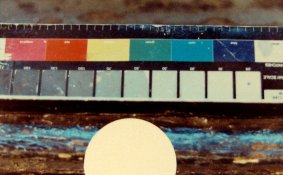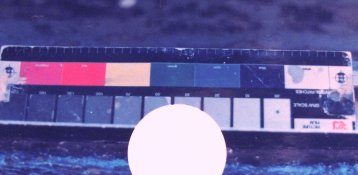Frotog and all: Here are my quick results. The (beat up) color swash was shot on my window sill under daylight only, with no camera filtration. They are not really sharp images because of the relatively slow shutter speed and hand held camera. I am glad frotog asked me for this because it gave me a better understanding of the drawbacks of this process. The circular part of each image was where I placed a penny in order to demonstrate how the base is represented when completely unexposed. The benchmark is the Kodak Supra II that I bought about five years ago (then, years old already!) and have kept it in my freezer since then. Development time was from 1 to 3 minutes, depending upon the needs for base density. Most people do not consider this base density, as it is assumed that there will be none. With fresh paper, in fact, you can double or triple your development time without worrying about acquiring a base density, but with age-fogged materials it is a mighty concern. (Yes, there is a tiny bit of yellow in the base of my benchmark, Supra II, but I could have used a bit of BZ to correct this. It is not objectionable.)
Benzotriazole (BZ) is a restrainer, usually favoring preservation of the densest parts of the image and primarily attacking the lesser densities; thus, a bit of contrast is added to the image. But, there is no ‘free lunch’ here, as the restraining action of the BZ causes what many of you already know with insufficient development of color paper: an overall bluishness (blue-blacks) that cannot be filtered out. But you DO get the nice white base. (With low levels of age fog this would not be a problem because there is a safety factor incorporated into the development time: ie, a little less development would not present these bluish blacks.) On the other hand, (see Agfa: NO BZ) you get ‘accurate’ color with fill development but suffer from overall orange caste caused by age-fog.
The Ektacolor Ultra was acquired without cost about five years ago from someone who does house ‘clean-outs’. I worried that this was stored in some attic where it got much heat. I must have been correct, as this paper shows dense fog when processed without the BZ. But, again, the colors are more ‘accurate’ than those of the Ultra processed with BZ, for which there was NO yellow in the filter pack. Yet I could not get less blue in the image but is almost sensational as to the quality of image I was able to attain here. Kodak paper ages more gracefully than most.
Again, BZ is VERY powerful with color developers. Take maybe 50ml of your color developer and put it into a small cup. Then, using an eyedropper, put a drop of the BZ stock into this developer and, in full room light, see how long it takes a tiny piece of color paper to turn black. Keep adding drops until takes about two or three times as long (depends upon extent of age fog) as for developer without BZ added. BZ stock = 1 gram BZ into 100ml water. Also, when you use BZ you will have to expose in the enlarger more because you are, essentially, under-developing. - David Lyga















